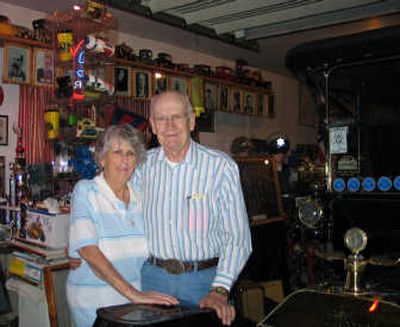Glen and Hazel Whiteley watch out for others

Sometimes good neighbors are not only good to the people who live nearby, but the community as a whole.
Glen and Hazel Whiteley have been shoveling snow, making cookies and making sure everyone is vigilant about crime for almost 36 years.
The Whiteleys moved into their South Hill home on Thanksgiving Day in 1971 in the middle of a snowstorm.
Perhaps that is why Glen spends a lot of time in the winter plowing the neighbors’ driveways, front walks and paths for the mail carriers.
Glen said that he doesn’t do it to go out of his way to be a good neighbor.
“I do the plowing because it’s healthy,” he said.
“He’s a very, very humble guy,” countered a neighbor, Holly Lewis.
Lewis said that the couple is always friendly, available to help and willing to go the extra step for her.
She said that he always brings the garbage cans up to his neighbors’ houses, and that has inspired her own children to bring the cans up before he does.
The two met in Germany during World War II. She was an Army nurse, and he was a technician in the Army’s psychology department.
While they were there, they helped to build the hospital at Landstuhl.
When the war was over, Hazel went back to her native Kansas.
“I decided to chase her down,” Glen said.
The two will have been married 53 years this Christmas.
Glen, who once worked for the Sheriff’s Department, likes to keep an eye on everyone in the neighborhood to make sure that they are all safe. He will make sure that everyone keeps their garage doors closed and keeps an eye out for people who don’t belong in the area.
Hazel has been known to make cookies for the newest members of the neighborhood to introduce themselves.
Once Glen saw some young men in the neighborhood who looked like they were seeking magazine subscriptions. When they reached his house, they noticed a picture of a paddy wagon at their front door and changed their story. All of a sudden, they were looking for a lost dog.
“I ran them off,” Glen said.
But the Whiteleys are not only good neighbors, they are preserving history for Spokane.
One day, Lewis pulled into her driveway and Glen was dressing a mannequin. When she asked him what he was doing, he invited her into the house.
Since 1990, the Whiteleys have been collecting photos, cars, shackles, guns, uniforms motorcycles, patches, radios and old sirens for the Law Enforcement Museum.
Glen started his collection after he retired and realized that there was plenty of history within the various branches of law enforcement that was being lost. He started out by collecting patches and now has an extensive collection of just about everything tied to law enforcement.
The museum doesn’t have its own building yet, so the Whiteleys keep the items in their garage and basement.
Both rooms are jam-packed with mementoes and items from days gone by. Glen, who has worked as a photographer, teacher, and in forensics science with the state of Washington, has extensive knowledge of the history of law enforcement.
Not only does he collect old uniforms, he probably knew the person who wore it.
Glen is a serious collector, but items for the museum aren’t his only interests.
The two are members of a Model T club, and Glen has a collection of more than 1,000 cameras in a corner of his basement.
If there is an event for the Police Department, the Whiteleys are sure to turn up in their 1915 Model T Ford, which is decked out to look like an old police car. Glen wears a replica of a police uniform from 1888, and Hazel will wear vintage clothes also.
They’ve participated in the Lilac Parade many times, and once, Glen broke his arm when he was starting the car with the crank.
Not wanting to let his passengers down, he made it through the whole parade before he went to the hospital.
Although Lewis is impressed with the museum, she is just thrilled to have the Whiteleys as neighbors.
She said once there was a drug house in the neighborhood. The Whiteleys kept track of license plates and helped to get the drug dealers to move away.
“They’re kind of like the core of the neighborhood,” Lewis said.